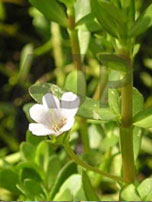SHAHEED KARTAR SINGH SARABHA AYURVEDIC MEDICAL COLLEGE & HOSPITAL
Affiliated to Guru Ravidas Ayurved University, Hoshiarpur Punjab
Affiliated to Guru Ravidas Ayurved University, Hoshiarpur Punjab

Botanical Name: Bacopa monnieri (Linn.) Penn
Family: Scrophulariaceae
Introduction:
The controversy on Brãhmi and Mandükaparni is never ending. both used as brain tonic. Usually South Indians Bacopa as brahmi, North Indians using Centella asiatica
Names in different Indian languages:
Hindi: Brahmi,jalnim
Telugu: Sambranicettu
Tamil: Nirpirami
English: Thyme leaved gratiola
Marathi: Brahmi
Bengali: Brahmi
Kanada: Nirbrahmi
Malayalam: Brahmi
Unani: Brahmi
Sanskrit: Brahmi,sarasvati
Synonyms:
Aindri, Nirbraahmi, Kapotavankaa, Bhaarati, Darduradalaa, Matsyaakshaka, Shaaluraparni, Mandukaparni
Herpestis monnieria (Linn.) H. B. & K.,Moniera cuneifolia Michx
Classification according to Charaka, Susrutha & Vagbhata:
Charaka: Prajasthapana
Varieties & adulterants – (CV – controversy, AD – adulterants):
Centella asiatica [CV]
Tamarachuda patika – a medya drug
Morphology:
A glabrous, punctate. succulent creeping annual herb.
Leaves- simple, sessile, obovate or spathulate, entire, fleshy
Flowers- solitary. axillary, white; bracteoles linear.
Fruits- ovoid, acute, acute capsules included in the persistent calyx.
Flowers and fruits almost throughout the year (mainly between February—April)
Habitat & Distribution:
Common in moist places throughout India
Chemical composition:
monnierin, hersaponin, bacosides A and B. Bacosides A and B , Ascorbic acid, nicotinic acid, brahmine, herpestine. alanine,
hentri-acontane, octacosane. monnierin (saponin), hersaponin, bacoside A & B, bacogenins A1-A4 (Sapogenins). 13-sitosterol etc.
Properties:
Rasa: Tikta, Kasäya
Guna: Laghu
Virya: sita
Vipaka: Madhura
Karma: Kapha-pitta hara, Medhya, Rasãyana , kandughna,arsoghna, vranahara
Cooling, laxative, intellect promoting, anodyne, carminative, digestive, anti inflammatory, depurative, bronchodilator, diuretic, cardiotonic, febrifuge
Part Used: Whole plant
Dosage: Fresh juice 10-20 ml
Indications:
Apasmãra, Prameha, Kustha, Pandu, Prameha, Sotha, Jvara, Kãsa,gulma
neuralgia, epilepsy, insanity, insomnia, dementia, tumors, ulcers, splenomegaly, ascites, constipation, sterility.
Internal uses:
Nervous system : Brahmi is a valuable plant for brain and entire nervous system. Mania and epilepsy are two conditions which require brahmi. It also helps in depression and mental retardation. by enhancing intelligence.
Digestive system Brahmi is slightly astringent and hence useful in diarrhea. Brahmi may suppress appetite, hence deepan medicines should be given along with it.
Respiratory system : Specially in children, for cold and cough. 1 teaspoonful of brahmi juice is given to induce vomiting and gives relief. When hoarseness of voice results from excessive talking, pills made from the leaves of brahmi. vasa, pippali. haritaki and vacha are chewed which gives relief.
Cardiovascular system: In small doses, it has cardiotonic property, It leads to an increase in blood pressure.
Urinary system : Diuretic.
Temperature : In Srilanka, brahmi is used for fever,
Satmikaran : Brahmi is a brain tonic. It enhances memory, intelligence and longevity..
Srotogamitwa:
Dosha : Vataghna, pittaghna, kaphaghna, tridoshanashak
Dhatu: Meda (demulcent). strengthens all seven dhatus (anaemia, urinary disorders).
Mala : Urine (diuretic), keshya (hair growth).
Prabhava : Antidote.
Important Yogas or Formations:
Brahmi prash: Saraswatarishta, Brahmighmta, Brahmitaila. Brãhmi rasãyana, Brãhmighrta
